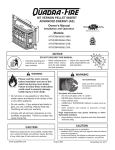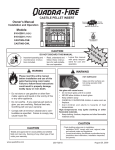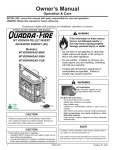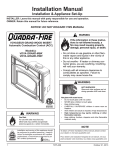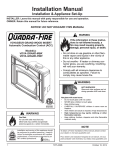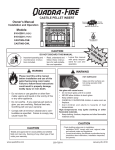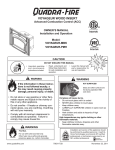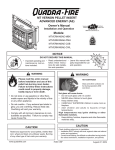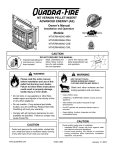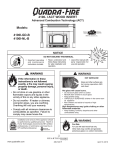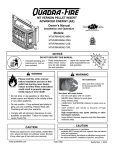Download Quadra-Fire MTVERNINSAE-PMH Installation manual
Transcript
Installation Manual Installation & Appliance Set-Up INSTALLER: Leave this manual with party responsible for use and operation. OWNER: Retain this manual for future reference. NOTICE: DO NOT DISCARD THIS MANUAL WARNING If the information in these instructions is not followed exactly, a fire may result causing property damage, personal injury, or death. MT VERNON PELLET INSERT ADVANCED ENERGY (AE) Model(s): MTVERNINSAE-MBK • Do not store or use gasoline or other flammable vapors and liquids in the vicinity of this or any other appliance. MTVERNINSAE-PMH • Do not overfire - If heater or chimney connector glows, you are overfiring. Overfiring will void your warranty. MTVERNINSAE-CSB • Comply with all minimum clearances to combustibles as specified. Failure to comply may cause house fire. WARNING HOT SURFACES! Glass and other surfaces are hot during operation AND cool down. Tested and Listed by Portland Oregon USA O-T L C US OMNI-Test Laboratories, Inc. CAUTION Tested and approved for wood pellets, shelled field corn, wheat and black oil sunflower seeds. Burning of any other type of fuel voids your warranty. Hot glass will cause burns. • Do not touch glass until it is cooled • NEVER allow children to touch glass • Keep children away • CAREFULLY SUPERVISE children in same room as fireplace. • Alert children and adults to hazards of high temperatures • High temperatures may ignite clothing or other flammable materials. • Keep clothing, furniture, draperies and other flammable materials away. NOTE CAUTION Check building codes prior to installation. • Installation MUST comply with local, regional, state and national codes and regulations. • Consult local building, fire officials or authorities having jurisdiction about restrictions, installation inspection, and permits. 1 To obtain a French translation of this manual, please contact your dealer or visit www.quadrafire.com Pour obtenir une traduction française de ce manuel, s’il vous plaît contacter votre revendeur ou visitez www.quadrafire.com 7036-188C June 19, 2014 MT VERNON AE INSERT Safety Alert Key: • DANGER! Indicates a hazardous situation which, if not avoided will result in death or serious injury. • WARNING! Indicates a hazardous situation which, if not avoided may result in death or serious injury. • CAUTION! Indicates a hazardous situation which, if not avoided, may result in minor or moderate injury. • NOTICE: Indicates practices which may cause damage to the appliance or to property. TABLE OF CONTENTS 1 Important Safety Information ............3 4 Vent Information...............................12 A. B. C. D. E. Appliance Certification ......................................................3 BTU & Efficiency Specifications........................................3 Glass Specifications .........................................................3 Electrical Rating................................................................3 Mobile Home Approved .................................................... 3 2 Getting Started ...................................4 A. Design, Installation & Location Considerations ..........................4 B. Thermostat Wall Control Location......................................5 C. Tools And Supplies Needed..............................................5 D. Inspect Appliance and Components .................................5 E. Install Checklist ..................................................................6 3 Dimensions and Clearances .............7 A. Appliance Dimensions ......................................................7 B. Clearances to Combustibles (UL and ULC) .......................8 C. Masonry and Zero Clearance Fireplaces ..........................9 D. Floor Protection .................................................................9 E. Minimum Opening for Masonry & Zero Clearance Fireplaces .................................................9 F. Mantel Projections ..............................................................9 G. Removing Metal Floor of Factory-Built Firebox .................10 H. Prefabricated Metal Chimney ............................................11 I. Altering the Factory-Built Fireplace .....................................11 A. Venting Termination Minimum Requirements ...................12 B. Avoiding Smoke and Odors ...............................................13 C. Negative Pressure ............................................................14 D. Draft..... ............................................................................. 14 E. Chimney and Exhaust Connection ...................................14 F. Equivalent Feet of Pipe ....................................................15 G. Pipe Selection Chart ........................................................15 5 Venting Systems ..............................16 A. Full Reline With Outside Air - Horizontal ...........................16 B. Full Reline With Outside Air - Vertical ...............................17 6 Appliance Set-Up .............................18 A. Leveling System ...............................................................18 B. Outside Air Kit Instructions ................................................18 C. Hearth Support .................................................................19 D. Removal of Cast Sides ....................................................19 E. Surround and Trim Set - Cast ...........................................20 F. Surround & Trim Set, Basic ...............................................20 G. Optional Log Set Placement Instructions .........................21 H. Wall Control Thermostat Installation .................................21 7 Mobile Home Installation.................22 8 Accessory List .................................23 300 Watt Igniters come installed in brand new Mt. Vernon AE units and are for pellet fuel only. The 380 Watt Igniter is required for burning multi-grain fuels and is included in the component pack. Multi-fuels include, corn, sunflower seeds, and wheat. 2 7036-188C June 19, 2014 MT VERNON AE INSERT 1 Important Safety Information A. Appliance Certification Model OMNI Test Laboratories, Inc. Report No. 061-S-69-6 Type Solid Fuel Room Heater/Pellet Type Insert FCC • This appliance is approved for mobile home installations when not installed in a sleeping room and when an outside combustion air inlet is provided. Mt. Vernon Pellet Insert AE Laboratory Standard E. Mobile Home Approved • The structural integrity of the mobile home floor, ceiling, and walls must be maintained. • The appliance must be properly grounded to the frame of the mobile home and use only Listed pellet vent Class “L” or “PL” connector pipe. ASTM E1509-04, ULC S628-93 and ULC/ORD-C1482-M1990 Room Heater Pellet Fuel Burning type and (UM) 84-HUD, Mobile Home Approved. Complies with Part 15 of FCC Rules. Operation is subject to the following two conditions: (1) this device may not cause harmful interference, and (2) this device must accept any interference received, including interference that may cause undesired operation. • Outside Air Kit, part OAK-ACC must be installed in a mobile home installation. NOTICE: This installation must conform with local codes. In the absence of local codes you must comply with the ASTM E1509-04, ULC S628-93, (UM) 84-HUD and ULC/ORDC-1482-M1990. WARNING Fire Risk. Hearth & Home Technologies disclaims any responsibility for, and the warranty will be voided by, the following actions: B. BTU & Efficiency Specifications EPA: Compliant *BTU Input: 14,620 - 52,500 / hr Efficiency: Up to 86.5% Heating Capacity: Up to 3,000 square feet depending on climate zone Vent Size: 3” or 4” Type “L” or “PL” Hopper Capacity: 56 lbs +/-5 lbs Fuels: Pellets, Shelled Field Corn, Wheat and Black Sunflower Seeds Shipping Weight: • Installation and use of any damaged appliance. • Modification of the appliance. • Installation other than as instructed by Hearth & Home Technologies. • Installation and/or use of any component part not approved by Hearth & Home Technologies. • Operating appliance without fully assembling all components. • Operating appliance without legs attached (if supplied with unit). • Do NOT Overfire - If appliance or chimney connector glows, you are overfiring. Any such action that may cause a fire hazard. 425 lbs *BTU will vary, depending on the type of fuel you use in your appliance. Consult your Quadra-Fire dealer for best results. Improper installation, adjustment, alteration, service or maintenance can cause injury or property damage. For assistance or additional information, consult a qualified installer, service agency or your dealer. C. Glass Specifications This stove is equipped with 5mm ceramic glass. Replace glass only with 5mm ceramic glass. Please contact your dealer for replacement glass. D. Electrical Rating 115 VAC, 60 Hz, Start 5 Amps, Run 1.25 Amps June 19, 2014 NOTE: Hearth & Home Technologies, manufacturer of this appliance, reserves the right to alter its products, their specifications and/or price without notice. Quadra-Fire is a registered trademark of Hearth & Home Technologies. 7036-188C 3 MT VERNON AE INSERT 2 Install Guide Getting Started A. Design, Installation & Location Considerations 1. Appliance Location NOTICE: Check building codes prior to installation. • Installation MUST comply with local, regional, state and national codes and regulations. • Consult insurance carrier, local building inspector, fire officials or authorities having jurisdiction over restrictions, installation inspection and permits. Since pellet exhaust can contain ash, soot or sparks, you must consider the location of: • • • • • • Windows Air Intakes Air Conditioner Overhang, soffits, porch roofs, adjacent walls Landscaping, vegetation Horizontal or vertical vent termination It is a good idea to plan your installation on paper, using exact measurements for clearances and floor protection, before actually beginning the installation. Location of the appliance and chimney will affect performance. 2. Floor Support Consideration must be given to: Ensure that your floor will support these weights prior to installation. Add sufficient additional support to meet this weight requirement prior to installation. The weight of the appliance is 425 lbs. • Safety, convenience, traffic flow • Placement of the chimney and chimney connector and to minimize the use of chimney offsets. The supporting floor under the appliance must be able to handle the weight of the appliance, fuel load and the weight of the chimney. WARNING • Place the appliance where there will be a clear passage for a Listed chimney through the ceiling and roof (vertical) or through exterior wall (horizontal). Risk of Fire Damaged parts could impair safe operation. Do NOT install damaged, incomplete or substitute components. • Installing the required outside air kit will affect the location of the vent termination. When locating vent and venting termination, the ideal location is to vent above roof line when possible. This minimizes the affects of wind loading. CAUTION If burning shelled field corn, you must use approved venting specifically designed for corn to prevent corrosion or degradation. Follow the instructions from the venting manufacturer. Recommended Location: • Above peak Recommended Location: • Above peak • Inside heated space Marginal Location: • Below peak Marginal Location: • Wind loading possible Location NOT recommended: • Not the highest point of the roof • Wind loading possible Recommended: • Insulated exterior chase in cooler climates Location NOT recommended: • Too close to tree • Below adjacent structure • Lower roof line • Avoid outside wall Windward Leeward Recommended: Outside Air Intake on windward side Multi-level Roofs NOT recommended: Outside Air Intake on leeward side Figure 4.1 4 7036-188C June 19, 2014 MT VERNON AE INSERT B. Thermostat Wall Control Location D. Inspect Appliance and Components The thermostat wall control’s location will have some affect on the appliance’s operation. • Open the appliance and remove all the parts and articles packed inside the Component Pack. Inspect all the parts and glass for shipping damage. • Report to your dealer any parts damaged in shipment. • All labels have been removed from the glass door. • Plated surfaces have been wiped clean with a soft cloth, if applicable. • Read all the instructions before starting the installation. Follow these instructions carefully during the installation to ensure maximum safety and benefit. • Follow pipe manufacturer instructions for installation and air clearance requirements. • Maximum wire length from appliance is 100 feet (30.48m) continuous unspliced wire. Recommended 20 gauge wire, solid copper . • When located close to the appliance, it may require a slightly higher temperature setting to keep the rest of the house comfortable. • When located in an adjacent room or on a different floor level, you will notice higher temperatures near the appliance. CAUTION The wall control is an integral part of the appliance. No other wall control or thermostat can be substituted. C. Tools And Supplies Needed Tools and building supplies normally required for installation, unless installing into an existing masonry fireplace: Reciprocating Saw Hammer Tape Measure 1/4” Self-Tapping Screws Hi-temp Caulking Material Safety Glasses Electric Drill & Bits (1/4”) Channel Locks Phillips Screwdriver Plumb Line Framing Material Gloves Framing Square Level May also need: Vent Support Straps Venting Paint 300 Watt Igniters come installed in brand new Mt. Vernon AE units and are for pellet fuel only. The 380 Watt Igniter is required for burning multi-grain fuels and is included in the component pack. Multi-fuels include, corn, sunflower seeds, and wheat. WARNING Risk of Fire Damaged parts could impair safe operation. Do NOT install damaged, incomplete or substitute components. WARNING Hearth & Home Technologies disclaims any responsibility for, and the warranty will be voided by, the following actions: • Installation & use of any damaged appliance. • Modification of the appliance. • Installation other than as instructed by Hearth & Home Technologies. • Installation and/or use of any component part not approved by Hearth & Home Technologies. • Operating appliance without fully assembling all components. • Operating appliance without legs attached (if supplied with unit). • Do NOT Overfire Or any such action that may cause a fire hazard. June 19, 2014 7036-188C 5 MT VERNON AE INSERT E. Install Checklist ATTENTION INSTALLER: Follow this Standard Work Checklist This standard work checklist is to be used by the installer in conjunction with, not instead of, the instructions contained in this installation manual. Customer: Date Installed: Lot/Address: Location of Fireplace: Installer: Dealer/ Distributor Phone #: Serial #: Model (circle one): MTVERNINSAE-MBK MTVERNINSAE-PMH MTVERNINSAE-CSB WARNING! Risk of Fire or Explosion! Failure to install fireplace according to these instructions can lead to a fire or explosion. Appliance Install YES IF NO, WHY? Verified clearances to combustibles. (Pg. 8) Fireplace is leveled and liner is secured to appliance. (Pg. 18) Hearth extension size/height decided. (Pg. 22) Outside air kit installed. (Pg. 15) Floor protection requirements have been met. The masonry chimney is inspected by a professional and is clean or the factory built metal chimney is installed according to the manufacturer’s instructions and clearances. Chimney Section 4 (Pg. 10) Chimney configuration complies with diagrams. Chimney installed, locked and secured in place with proper clearance. Chimney meets the minimum height requirements. Roof flashing installed and sealed. Terminations installed and sealed. Clearances Section 3 (Pg. 7) Combustible materials not installed in non-combustible areas. Verified all clearances meet installation manual requirements. Mantels and wall projections comply with installation manual requirements. Protective hearth strips and hearth extension installed per manual requirements. Appliance Setup Section 5 (Pg. 15) All packaging and protective materials removed. Firebrick, baffle and ceramic blanket installed correctly. All labels have been removed from the door. All packaging materials are removed from inside/under the fireplace. Manual bag and all of its contents are removed from inside/under the fireplace and given to the party responsible for use and operation. Hearth & Home Technologies recommends the following: • Photographing the installation and copying this checklist for your file. • That this checklist remain visible at all times on the fireplace until the installation is complete. Comments: Further description of the issues, who is responsible (Installer/Builder/Other Trades, etc.) and corrective action needed: Comments communicated to party responsible by on (Builder/Gen. Contractor) (Installer) (Date) Part # 4017-254 • Rev B • 01/29/13 6 7036-188C June 19, 2014 MT VERNON AE INSERT 3 Dimensions and Clearances A. Appliance Dimensions 32 in. (812mm) 23-7/8 in. 8-1/8 in. (606mm) (206mm) 15 in. (382mm) CL 2-3/8 in. (59mm) 29-3/4 in. (756mm) 23-7/8 in. (605mm) 13-1/8 in. (333mm) 26-1/4 in. (667mm) 28-1/8 in. (714mm) Figure 7.1 - Top View Figure 7.2 - Side View 36-5/8 in. (929mm) 33 in. 838mm) 34-7/8 in. (886mm) 46-1/8 in. (1171mm) 50 in. (1270mm) Figure 7.3 - Front View with Basic Surround Panel Set June 19, 2014 Figure 7.4 - Front View with Cast Panel Set 7036-188C 7 MT VERNON AE INSERT B. Clearances to Combustibles (UL and ULC) Built-in Unit - Rear Vent A D C B B C E 0 inch Clearance To Exposed Section And Face Trim Figure 8.1 Location A Top of Hopper Configuration Inches Millimeters 3 76 Top or Rent Vent B Side of Outside Skin Top or Rear Vent 2 51 C Back of Hopper Top Vent 7-1/2 191 Rear Vent 2-3/4 70 D Vent Pipe to Combustible Top or Rear Vent 3 76 E Cast Side to Side Wall Top or Rear Vent 6 152 Built-in Unit - Rear Vent with Outside Air WARNING Fire Risk. Comply with all minimum clearances to combustibles as specified. Failure to comply may cause house fire. NOTE: • • • Illustrations reflect typical installations and are FOR DESIGN PURPOSES ONLY. Illustrations/diagrams are not drawn to scale. Actual installation may vary due to individual design preference. Figure 8.2 8 7036-188C June 19, 2014 MT VERNON AE INSERT Built-In Vertical E. Minimum Opening for Masonry & Zero Clearance Fireplaces A C B Figure 9.3 Location Figure 9.1 C. Masonry and Zero Clearance Fireplaces Inches Millimeters F Rear Width 24 610 G Depth 15 381 H Height 23-7/8 606 I Front Width 34 864 Face Trim Mantel Side Wall F. Mantel Projections B A J C K D E Figure 9.2 Location A Insert side to combustible side wall Inches 6 Millimeters 152 B Insert top to max. 2-1/4 inch face trim 0 0 C Insert side to max. 2-1/4 inch face trim 0 0 D. Floor Protection Location Inches Millimeters D Floor protection hearth extension from door opening 6 152 E Floor protection to the side of door opening 6 152 • • Figure 9.4 Use a non-combustible floor protector, extending beneath appliance and to the front, and sides as indicated. If employing a hearth extension, any parts or materials used in construction must be non-combustible. June 19, 2014 The maximum mantel depth (J) is 12 inches (305mm) with a minimum vertical height (K) of 12 inches (305mm). However if your mantel has a depth of 10 inches (254mm) then the vertical minimum height is 10 inches (254mm). 7036-188C 9 MT VERNON AE INSERT G. Removing Metal Floor of Factory-Built Firebox • • • The firebrick (refractory), glass doors, screen rails, screen mesh and log grates can be removed from a factory-built firebox in order to gain minimum insert opening requirements. Any smoke shelves, shields and baffles may be removed from a factory-built firebox if attached with mechanical fasteners. Use 2 x 4 from insert packaging to support insert The metal floor of the factory-built firebox may be removed to facilitate the installation of the insert only when a 1/4 inch (6mm) airspace is provided between the insert and the floor of outer wrap. The following is only one example as there are many different models of factory-built fireplaces. Figure 10.3. If the floor is made of thin metal, we recommend using the 2 x 4 from the insert packaging to support the insert. The 2 x 4 may need to be cut to the appropriate size. Starter hole Keep sharp edge of metal floor away from power cord Mark area of floor to cut Figure 10.1. Measure and mark the metal floor for cutting. With a drill, make a starter hole in each corner. Figure 10.4. Place the insert into the factory-built firebox. Ensure that the power cord can not be damaged by the sharp metal edge. You may need to cut out a notch to accommodate the cord. Leveling Leg Figure 10.2. Using a saws-all, cut out the floor. Figure 10.5. Ensure that the leveling leg is positioned over the 2 x 4 before leveling the insert. 10 7036-188C June 19, 2014 MT VERNON AE INSERT H. Prefabricated Metal Chimney I. Altering the Factory-Built Fireplace The chimney can be new or existing, masonry or prefabricated and must meet the following minimum requirements: • • Must be minimum 6 inch (152mm) inside diameter of high temperature chimney listed to UL 103 HT (2100oF) or ULC-S628. The following modifications are permissible: • • • • • • • Must use components required by the manufacturer for installation. • Must maintain clearances required by the manufacturer for installation. • Refer to manufacturers instructions for installation •This insert is listed to ASTM E 1509 Standard and is approved for installation into listed factory-built zero clearance fireplaces listed to UL 127 conforming to the following specifications and instructions: •The liner must be securely attached to the insert flue collar and the chimney top. •The air flow of the factory-built zero-clearance fireplace system must not be altered. The flue liner top support attachment must not reduce the air flow for the existing air-cooled chimney system. •No dilution air is allowed to enter the chimney. Removal of damper or locked in open position Removal of smoke shelf or baffle Removal of ember catches Removal of fire grate Removal of view screen/curtain Removal of doors • External trim pieces which do not affect the operation of the fireplace may be removed providing they can be stored on or within the fireplace for reassembly if the insert is removed. • The permanent metal warning label provided must be attached to the back of the fireplace, with screws or nails, stating that the fireplace may have been altered to accommodate the insert, and must be returned to original condition for use as a conventional fireplace. Figure 11.1 • If the hearth extension is lower than the fireplace opening, the portion of the insert extending onto the hearth must be supported. • Manufacturer designed adjustable support kit can be ordered from your dealer. • Final approval of this installation type is contingent upon the authority having jurisdiction. •The original factory-built clearance fireplace chimney cap must be re-installed after installing the approved chimney liner meeting type UL 103 HT requirements (2100°F) per UL 1777. •If the chimney is not listed as meeting HT requirements, or if the factory built fireplace was tested prior to 1998, a full height listed chimney liner must be installed from the appliance flue collar to the chimney top. The fireplace must not be altered, except for the exceptions listed below. Do not remove the bricks and mortar from the existing fireplace. NOTE: Refer to chimney liner manufacturer for recommendations on supporting the liner. Installation into fireplaces without a permit will void the listing 1. Secure the fireplace damper in the open position. If this cannot be accomplished, it will be necessary to remove the damper WARNING 2. Seal damper area of chimney around chimney connector with a high temperature sealant or seal insert against the face of the fireplace. Fire Risk. Follow venting manufacturer’s clearances and instructions when installing venting system. 3. Both methods must be removable and replaceable for cleaning and re-installation. NOTICE: In Canada when using a factory-built chimney it must be safety listed, Type UL103 HT (2100oF) [1149oC] CLASS “A” or conforming to CAN/ULC-S629M, STANDARD FOR 650oC FACTORY-BUILT CHIMNEYS. WARNING THIS FIREPLACE MAY HAVE BEEN ALTERED TO ACCOMMODATE AN INSERT. IT MUST BE RETURNED TO ITS ORIGINAL CONDITION BEFORE USE AS A SOLID FUEL BURNING FIREPLACE. 250-2061 250-2061 Figure 11.1 June 19, 2014 7036-188C 11 MT VERNON AE INSERT 4 Vent Information A. Venting Termination Minimum Requirements V N V N Inside Corner Electrical Service N V N V G V A D O V P E L C V B FIXED CLOSED V F FIXED CLOSED OPEN V B OPEN G M V V V Termination Cap I A B B Figure 12.1 H X Air Supply Inlet V X J or K G Gas Meter Restricted Area All minimum clearances are listed with an Outside Air Kit (OAK) installed, unless otherwise noted in table below. A 12 in. Above Finish Grade (the grade surface must be a non-combustible material 24 in. Above grass, top of plants, wood or any other combustible B 12 in. 48 in. no OAK Open door or window: below or to the side 12 in. 36 in. no OAK Clearance from any forced air intake of other appliance B 12 in. Open door or window: above 12 in. Clearance horizontally from combustible wall C 6 in. Permanently closed window: above, below or to the side 15 in. Vented directly through a wall, minimum length of horizontal pipe D 18 in. 36 in. no OAK Vertical clearance to a ventilated soffit located above the terminal within a horizontal distance of 2 ft from the center-line of the terminal 6 in. horizontal 12 in. vertical Minimum horizontal or vertical terminations must protrude from wall NOTICE: E 12 in. Clearance to unventilated soffit Do NOT Terminate Vent: F 12 in. Clearance to outside corner • G 12 in. Clearance to inside corner In any location that will allow flue gases or soot from entering or staining the building H 36 in. Above gas meter/regulator measured from horizontal center-line of regulator • In any location which could create a nuisance or hazard I 36 in. USA 72 in. Canada Clearance to service regulator vent outlet • J 12 in. 48 in. no OAK Clearance to non-mechanical air supply inlet to the building or the combustions air inlet to any other appliance In any enclosed or semi-enclosed area such as a carport, garage, attic, crawl space, under a sun deck or porch, narrow walkway • K 10 ft horizontal 3 ft vertical Clearance to mechanical air supply Closely fenced area, or any location that can build up a concentration of fumes such as a stairwell, covered breezeway, etc. L 7 ft. Above paved sidewalk, paved driveway located on public property M 12 in. Under an open veranda, porch, deck or balcony N See Note below* Electric service: above, below or to the side (location must not obstruct or interfere with access) O 24 in. Adjacent building, fences and protruding parts of the structure P 12 in. Clearance above roof line for vertical terminations NOTICE: Termination must exhaust above air inlet elevation. *NOTE: Consult local building, fire officials or authorities having jurisdiction. Local codes or regulations may require different clearances. 12 • It is recommended that at least 60 inches (1.52m) of vertical pipe be installed when appliance is vented directly through a wall. This will create a natural draft, which will help prevent the possibility of smoke or odor venting into the home during a power outage. • It will also keep exhaust from causing a nuisance or hazard by exposing people or shrubs to high temperatures. • The safest and preferred venting method is to extend the vent vertically through the roof or above the roof. 7036-188C June 19, 2014 MT VERNON AE INSERT B. Avoiding Smoke and Odors Vent Configurations Negative Pressure, Shut-Down and Electrical Power Failure To reduce probability of reverse drafting during shut-down conditions Hearth & Home Technologies strongly recommends: To reduce the probability of back-drafting or burn-back in the pellet appliance during power failure or shut down conditions, it must be able to draft naturally without exhaust blower operation. • Installing the pellet vent with a minimum vertical run of 5 feet (1.52m). Preferably terminating above the roof line. • Installing the outside air kit at least 4 feet (1.22m) below the vent termination. Negative pressure in the house will resist this natural draft if not accounted for in the pellet appliance installation. Heat rises in the house and leaks out at upper levels. This air must be replaced with cold air from outdoors which flows into lower levels of the house. Vents and chimneys into basements and lower levels of the house can become the conduit for air supply and reverse under these conditions. Outside Air An outside air kit is recommended in all installations. The Outside Air Kit must be ordered separately. Per national building codes, consideration must be given to combustion air supply to all combustion appliances. Failure to supply adequate combustion air for all appliance demands may lead to back-drafting of those and other appliances. To prevent soot damage to exterior walls of the house and to prevent re-entry of soot or ash into the house: • Maintain specified clearances to windows, doors and air inlets, including air conditioners. • Vents should not be placed below ventilated soffits. Run the vent above the roof. • Avoid venting into alcove locations. • Vents should not terminate under overhangs, decks or onto covered porches. • Maintain minimum clearance of 12 inches (305mm) from the vent termination to the exterior wall. If you see deposits developing on the wall, you may need to extend this distance to accommodate your installation conditions. When the appliance is roof vented (strongly recommended): The air intake is best located on the exterior wall oriented towards the prevailing wind direction during the heating season. When the appliance is side-wall vented: The air intake is best located on the same exterior wall as the exhaust vent outlet and located lower on the wall than the exhaust vent outlet. The outside air supply kit can supply most of the demands of the pellet appliance, but consideration must be given to the total house demand. House demand may consume the air needed for the appliance. It may be necessary to add additional ventilation to the space in which the pellet appliance is located. Consult with your local HVAC professional to determine the ventilation demands for your house. June 19, 2014 CAUTION • DO NOT CONNECT THIS UNIT TO A CHIMNEY FLUE SERVICING ANOTHER APPLIANCE. • DO NOT CONNECT TO ANY AIR DISTRIBUTION DUCT OR SYSTEM. Optional Battery Back-Up Hearth & Home Technologies supplies an optional battery back-up system that operates the appliance during power failure conditions to prevent smoking. In shutdown mode, the battery back-up will not prevent smoking. Hearth & Home Technologies assumes no responsibility for, nor does the warranty extend to, smoke damage caused by reverse drafting of pellet appliances under shut down or power failure conditions. 7036-188C 13 MT VERNON AE INSERT C. Negative Pressure D. Draft Negative pressure results from the imbalance of air available for the appliance to operate properly. It can be strongest in lower levels of the house. Draft is the pressure difference needed to vent an appliance successfully. When an appliance is drafting successfully, all combustion byproducts are exiting the home through the chimney. Causes include: Install through the warm airspace enclosed by the building envelope. This helps to produce more draft, especially during lighting and die-down of the fire. • Exhaust fans (kitchen, bath, etc.) • Range hoods • Combustion air requirements for furnaces, water heaters and other combustion appliances • Clothes dryers • Location of return-air vents to furnace or air conditioning • Imbalances of the HVAC air handling system • Upper level air leaks such as: • • Preventing negative pressure Location of appliance and chimney NOTICE HEARTH & Home Technologies assumes no responsibility for the improper performance of the chimney system caused by: • Inadequate draft due to environmental conditions • Downdrafts • Tight sealing construction of the structure • Mechanical exhausting devices - Recessed lighting - Attic hatch - Duct leaks To minimize the effects of negative air pressure: • Considerations for successful draft include: Install the outside air kit with the intake facing prevailing winds during the heating season • Ensure adequate outdoor air for all combustion appliances and exhaust equipment • Ensure furnace and air conditioning return vents are not located in the immediate vicinity of the appliance • Avoid installing the appliance near doors, walkways or small isolated spaces • Recessed lighting should be a “sealed can” design • Attic hatches weather stripped or sealed • Attic mounted duct work and air handler joints and seams taped or sealed WARNING Risk of Asphyxiation! Negative pressure can cause spillage of combustion fumes and soot. E. Chimney and Exhaust Connection 1. Chimney & Connector: Use 3 or 4 inch (76-102mm) diameter type “L” or “PL” venting system. It can be vented vertically or horizontally. 2. Mobile Home: Approved for all Listed pellet vent. If using the 3 inch (76mm) vertical Top Vent Adapter Kit or the 3 to 6 inch (76-152mm) Top Vent Offset Adapter, use Listed double wall flue connector. A Quadra-Fire Outside Air Kit must be used with manufactured home installations. 3. Residential: The 3 inch (76mm) vertical Top Vent Adapter Kit and the 3 to 6 inch (76-152mm) Top Vent Offset Adapter are tested to use 24 gauge single wall flue connector or Listed double wall flue connector to Class A Listed metal chimneys, or masonry chimneys meeting International Residential Code standards for solid fuel appliances. 4. INSTALL VENT AT CLEARANCES SPECIFIED BY THE VENT MANUFACTURER. 5. Secure exhaust venting system to the appliance with at least 3 screws. Also secure all connector pipe joints with at least 3 screws through each joint. 6. DO NOT INSTALL A FLUE DAMPER IN THE EXHAUST VENTING SYSTEM OF THIS UNIT. 7. DO NOT CONNECT THIS UNIT TO A CHIMNEY FLUE SERVING ANOTHER APPLIANCE. NOTE: All pipe must be welded seam pipe whenever possible. Seal pipe joints with high temperature silicone (500°F [260°C] minimum rated only). NOTE: If burning shelled field corn, you must use approved venting specifically designed for corn. Follow the instructions from the venting manufacturer. 14 7036-188C June 19, 2014 MT VERNON AE INSERT F. Equivalent Feet of Pipe WARNING The table below can help you calculate the equivalent feet of pipe which is a method used to determine pellet vent size. Figure 15.1. Vent surfaces get HOT, can cause burns if touched. Non-combustible shielding or guards may be required. Example of 3 Elbow-Rear Vent Termination Calculation Pellet Venting Component # of Elbows 90o Elbow or Tee 3 2 ft. Feet of Multiplied Pipe By 45o Elbow 3 ft. Equivalent Feet Equivalent Feet X 5 15 X 3 Horizontal Pipe 7 X 1 Vertical Pipe 2 X 0.5 Components 7 1 Total Equivalent Feet 23 2 ft. Note: This is a generic example and is not intended to represent any specific fuel type. 2 ft. Figure 15.1 G. Pipe Selection Chart 30 The chart will help you in determining proper venting size according to the equivalent feet of pipe calculated previously and the altitude above sea level of this installation. Figure 15.2 4 in. (102mm) Diameter Pipe Only Example 1 20 Equivalent Pipe Length In Feet Example 2 a. Locate the calculated equivalent feet of pipe on the vertical left side of the chart. 10 3 in. or 4 in. (76mm or 102mm) Diameter Pipe b. Move to the right horizontally on the chart until you reach your altitude above sea level. 0 1 2 3 4 5 6 7 8 9 10 ALTITUDE IN THOUSANDS OF FEET c. If you fall below the diagonal line, 3 or 4 inch (76 to 102mm) pipe may be used. Figure 15.2 d. If it is anywhere above the diagonal line, a 4 inch (102mm) diameter pipe is required. Example 1: If the equivalent length of pipe is 23 feet (7m) with altitude of 8,000 feet (2438m) you must use 4 inch (102mm) diameter type “L” or “PL” vent. NOTICE: • A 90° elbow is 5 times as restrictive to the flow of exhaust gases under positive pressure as 1 foot (305mm) of horizontal pipe. • A foot of horizontal pipe is twice as restrictive as a foot of vertical pipe. Example 2: If the equivalent length of pipe is 12 feet (3.7m) with altitude of 6,000 feet (1829m) you may use 3 or 4 inch (76 to 102mm) diameter type “L” or “PL” vent. WARNING RISK OF INJURY OR PROPERTY DAMAGE! WARNING • Fire Risk. • Only LISTED venting components may be used. Improper installation, adjustment, alteration, service or maintenance can cause injury or property damage. • Refer to the owner’s information manual provided with this appliance. • For assistance or additional information consult a qualified installer, service agency or your dealer. • NO OTHER vent components may be used. • Substitute or damaged vent components may impair safe operation. June 19, 2014 7036-188C 15 MT VERNON AE INSERT 5 Venting Systems A. Full Reline With Outside Air - Horizontal WARNING Fire Risk. Inspection of Chimney: • Masonry chimney must be in good condition. • Meets minimum standard of NFPA 211 • Factory-built chimney must be a minimum 6 inch (152mm) UL103 HT. CAUTION Never draw outside combustion air from: • Wall, floor or ceiling cavity • Enclosed space such as an attic or garage NOTE; Use metal plate around exhaust vent pipe and seal all edges with non-flammable insulation such as fiberglass, mineral wool or ceramic. Do not use high temperature caulking materials to seal any edge to prevent furture serviceability. Outside Air through Rear Wall (Horizontal) Figure 16.1 NOTE: In Canada, where passage through a wall or partition of combustible construction is desired, the installation shall conform to CAN/CSA-B365. 16 NOTE: • Illustrations reflect typical installations and are FOR DESIGN PURPOSES ONLY. • Illustrations/diagrams are not drawn to scale. • Actual installation may vary due to individual design preference. 7036-188C June 19, 2014 MT VERNON AE INSERT B. Full Reline With Outside Air - Vertical NOTE: Check clearances carefully for this type of installation to ensure adequate room for outside air venting. NOTE: In Canada only a full reline is allowed per ULC S628, ORD ULC C1482-M1990. 305mm min. above 305mm min. below NOTE; Use metal plate around exhaust vent pipe and seal all edges with non-flammable insulation such as fiberglass, mineral wool or ceramic. Outside Air Termination at Chimney Top (Vertical) Do not use high temperature caulking materials to seal any edge to prevent furture serviceability. Figure 17.1 NOTE: In Canada this fireplace insert must be installed with a continuous chimney liner of 6 inch (152mm) diameter extending from the fireplace insert to the top of the chimney. The chimney liner must conform to the Class 3 requirements of CAN/ULC-S635, Standard for Lining Systems for Existing Masonry or Factory-Built Chimneys and Vents, or CAN/ULC-S640, Standard for Lining Systems for New Masonry Chimneys. June 19, 2014 CAUTION Check building codes prior to installation. • Installation MUST comply with local, regional, state and national codes and regulations. • Consult local building, fire officials or authorities having jurisdiction about restrictions, installation inspection, and permits. 7036-188C 17 MT VERNON AE INSERT 6 Appliance Set-Up A. Leveling System B. Outside Air Kit Instructions The leveling bolts are located on the sides of the appliance, front and rear. To access the bolts, remove the front access panels. Reach in and turn the bolt to the desired height to level the appliance. Included in Kit: 2 wire ties, 1 collar assembly, 1 termination cap assembly, 1 trim ring, fasteners. NOTE: 3 INCH (76mm) ALUMINUM FLEX PIPE NOT INCLUDED. Tools Needed: Phillips head screw driver; wire cutters; hole saw or jig saw. 1. Measure distance from floor to air vent opening in appliance and mark location on wall. 2. Use saw to cut opening in wall. Cut a 3-1/2 to 4 inch (89-102mm) opening on inside wall and a 4 to 4-1/2 inch (102-114mm) opening on outside of house. 3. Use wire ties to secure flex pipe to collar assembly. 4. Slide trim ring over flex pipe and run pipe through wall. 5. Attach flex pipe (not included) to outside termination cap with second wire tie. 6. Secure termination cap to outside surface. 7. Secure trim ring to interior wall. Leveling Bolts - 2 on each side CAUTION Never draw outside combustion air from: • Wall, floor or ceiling cavity • Enclosed space such as an attic or garage Figure 18.1 Collar Wire Ties 3 inch Aluminum Flex Pipe (not included) Trim Ring Termination Cap Figure 18.2 18 7036-188C June 19, 2014 MT VERNON AE INSERT C. Hearth Support Included in Kit: (1) bottom, (1) trim front, (2) trim sides, (2) trim extensions Tools Needed: Phillips head screw driver, measuring tape, gloves 7. Place the assembled hearth support under the insert. Lower the leveling bolts if necessary to keep the insert level. 8. Open the door and attach the hearth support to the insert. There are 9 attachment holes. Figure 19.3. 1. Remove contents from box and lay on protective surface to avoid scratching the paint. 2. Lay front and sides face down. Bend the tabs down toward the inside. Figure 19.1. 9 attachment holes - 3 on each side and 3 in the front 3. The side pieces are shipped flat. It is must easier to flex the sides into a bowed position before installing. 4. Lay the cast bottom face up. Attach the 2 sides FIRST and then the front piece. Figure 19.2. 5. Turn the cast bottom right side up and attach the panel extensions. Note the alignment hole. 6. Attach the appropriate footers depending on the panels & trim set you are installing. The footers come in 2 sizes, 3 and 5 inches. Discard the footers not used. Figure 19.3 D. Removal of Cast Sides You will need to remove the cast sides in order to install the panel and trim set. 1. There is a latch on the back side of the cast side in the middle of the top opening of the cast side as indicated in Figure 19.4. Bend tabs down. Shipped flat from the factory. 2. Place your fingers inside the opening and squeeze the latch. The side can now be pulled toward you and removed. Place on a protective surface so as not to damage the finish. 3. To replace the side, set the bottom in first. Squeeze the latch in an open position. Place the cast side into position and then release the latch. The latch hooks onto a bracket to hold the side in place. Figure 19.1 3 inch high Set Location of Latch for Removing Cast Sides Attach Trim to Insert from inside Insert. 5 inch high Set Lower the leveling bolts if necessary to keep the insert level when installing the Hearth Support. 3 in Basic Cast 5 in Install Front Trim Last, Corner Overlap Side Trim Pieces Figure 19.2 June 19, 2014 Attach Trim to Base from underneath Figure 19.4 - Shown with Cast Panel Set 7036-188C 19 MT VERNON AE INSERT E. Surround and Trim Set - Cast F. Surround & Trim Set, Basic Included in Surround Kit: (2) side panels, left and right; (1) panel top; (1) fastener package. Included in Surround & Trim Kit: (2) corner brackets and set screws; (1) trim set, 3 piece; (2) side panels; (1) top panel; (4) screws. Included in Cast Trim Kit: (2) cast trim legs, left and right; (1) cast trim header; (2) cast trim footers, left and right; (1) fastener package. Tools Needed: Powered Phillips head screw driver Tools Needed: Powered Phillips head screw driver 1. Secure the top panel to the surround sides with the screws provided. Figure 20.3 1. Remove contents from box being careful not to scratch or damage the cast trim pieces. 2. Assemble the trim with the (2) corner brackets provided. Figure 20.4 2. Lay the surround set face down on protective covering to prevent scratching the painted surface. 3. Remove the 2 cast sides and slide the assembled trim over the assembled surround set. Figure 20.5 3. Secure the surround legs to top panel with the screws provided. 4. 4. Now bend the tabs down toward the backside of the panel set, 5 on top and 2 on each leg. Leave the panel set face down. Figure 20.1 Carefully slide surround and trim over the top of the insert into place matching the mounting holes on the panel with the mounting holes on the insert. Secure with screws provided. Figure 20.5 5. Place the corresponding cast trim pieces ( 2 cast trim legs and 1 cast trim header) underneath the panel set, also face down. Back of Top Surround 6. Place washer provided over tab and secure the trim and panel together with screw. Continue for all tabs. Screws 7. Secure cast footers with screws. 8. Remove both left and right cast sides from insert. Figure 20.5 Back of Side Surround Figure 20.3 9. Carefully slide surround and trim over the top of the insert into place matching the mounting holes on the panel with the mounting holes on the insert. Secure with screws provided. Figure 20.5. 2. Bend tabs down 1. Screw panels together 1. Screw panels together 2. Bend tabs down Figure 20.4 3. Install Cast Trim Header Figure 20.1 Shown with Trim Installed on Surround Set Figure 20.2- Completed View 20 Figure 20.5 7036-188C June 19, 2014 MT VERNON AE INSERT G. Optional Log Set Placement Instructions 2 PIECE LOG SET INSTALLATION 1. Place the left log as shown. There are 2 indentations in the bottom of the log to fit over the screw heads in the firebox. Figures 21.1 and 21.2. 2. Place the right log in front of the 2 screw heads in the firebox. Figures 21.3 & 21.4. CAUTION The center 3 screws are for the wall control thermostat wires and the 2 outer screws are mounting screw and should not have wires attached to them. The thermostat wires are color coded. The green wire is on the top, the white in the middle and the red on the bottom. Figure 21.5 There are colored dots corresponding with the same colored wire on the right side which are easily seen by the installer. If by chance it is put in upside down the dots will be on the left side and will not be visible. Logs are FRAGILE. Use extreme care when handling or cleaning logs. Log has indentations on the bottom to fit over the screw heads. CAUTION Shock hazard. • Do NOT remove grounding prong from plug. • Plug directly into properly grounded 3 prong receptacle. • Route cord away from appliance. • Do NOT route cord under or in front of appliance. Left Log Figure 21.2 Log fits over screws Figure 21.1 12 volt power inlet (for optional battery back-up) Right Log Household power inlet Log rests in front of screws Green wire White wire Red wire Figure 21.4 Figure 21.3 NOTICE: Due to the abrasive nature of a pellet appliance fire, the logs are not covered under warranty. Any placement variation other than shown here can cause excessive heat and shall void the appliance warranty. Thermostat wires in center 3 screws H. Wall Control Thermostat Installation 1. When mounting the wall control thermostat on the wall, be sure to follow your wall control’s installation instructions carefully. NOTE: The wall control thermostat should be mounted on an inside wall and not in direct line with the appliance convection air. NOTE: If the wall control thermostat is located too close to the appliance, you may need to set the temperature setting slightly higher to maintain the desired temperature in your home. 2. There is a 5 screw terminal block located at the lower left of the appliance, behind the cast side. June 19, 2014 Figure 21.5 7036-188C 21 MT VERNON AE INSERT 7 Mobile Home Installation CAUTION You must use a Quadra-Fire Outside Air Kit for installation in a mobile home. 1. An outside air inlet must be provided for the combustion air and must remain clear of leaves, debris, ice and/or snow. It must be unrestricted while the appliance is in use to prevent room air starvation which causes smoke spillage. Smoke spillage can also set off smoke alarms. 2. The combustion air duct system must be made of metal. It must permit zero clearance to combustible construction and prevent material from dropping into the inlet or into the area beneath the dwelling and contain a rodent screen. 3. The appliance must be secured to the mobile home structure by bolting it to the floor (using lag bolts). Use the same holes that secured the appliance to the shipping pallet. 4. The appliance must be grounded with #8 solid copper grounding wire or equivalent, terminated at each end with an NEC approved grounding device. 5. Refer to Clearances to Combustibles and floor protection requirements on page 8 for listings to combustibles and appropriate chimney systems. 6. THE STRUCTURAL INTEGRITY OF THE MOBILE HOME FLOOR, WALL AND CEILING/ROOF MUST BE MAINTAINED Do NOT cut through: • Floor joist, wall, studs or ceiling trusses. • Any supporting material that would affect the structural integrity. This unit is to be connected to a factory-built chimney conforming to CAN/ULC-S629, Standard for 650°C Factory-Built Chimneys. For removal of the chimney for mobile home transportation, contact the proper transportation officials. Spark Arrestor Cap Storm Collar Roof Flashing Use silicone to create an effective vapor barrier at the location where the chimney or other component penetrates to the exterior of the structure. 7. Follow the chimney manufacturer’s instructions when installing the vent system for use in a mobile home. 8. Installation shall be in accordance with the Manufacturers Home & Safety Standard (HUD) CFR 3280, Part 24. Joist Shield/Firestop Approved Class L or PL Pellet Vent Figure 22.1 CAUTION Never draw outside combustion air from: • Wall, floor or ceiling cavity • Enclosed space such as an attic or garage WARNING Products of combustion generate carbon monoxide and different fuels generate different levels. Carbon monoxide • Only use approved fuels in this appliance. • Always keep door shut during operation. Operating this unit with doors open can allow CO to leak into the home. WARNING It is critical to have a working smoke detector installed in the home of unit operation. • Smoke alarms that are properly installed and maintained play a vital role in reducing fire deaths and injuries. Having a working smoke alarm reduces the chance of fire related injuries. WARNING CO can kill you before you are aware it is in your home. At lower levels of exposure, CO causes mild effects that are often mistaken for the flu. These symptoms include headaches, dizziness, disorientation, nausea and fatigue. The effects of CO exposure can vary greatly from person to person depending on age, overall health and the concentration and length of exposure. NEVER INSTALL IN A SLEEPING ROOM. 22 7036-188C June 19, 2014 MT VERNON AE INSERT 8 Accessory List R MT VERNON INSERT-AE Service Parts Beginning Manufacturing Date: Sept. 2006 Ending Manufacturing Date: Active IMPORTANT: THIS IS DATED INFORMATION. Parts must be ordered from a dealer or distributor. Hearth and Home Technologies does not sell directly to consumers. Provide model number and serial number when requesting service parts from your dealer or distributor. ITEM DESCRIPTION COMMENTS Stocked at Depot PART NUMBER Accessories 12 Volt Power Cord 12VCORD-AE Y Damper, 3 Inch - Tall Vertical Installs Only PEL-DAMP3 Y Damper, 4 Inch - Tall Vertical Installs Only PEL-DAMP4 Firescreen SCR-7005 Hearth Support Log Set (2 Pc) ZCSPT-MVI Sold as set only LOGS-60-AE-B Outside Air Kit OAK-3 Surround, Std, Panel, For Cast Trim SP-MTVS-CST Component Pack 7036-041 Surround, Std, Panel, w/Gold Trim SP-MTVS-GD Component Pack 7036-042 Trim, Panel Set, Gold 250-4660 Surround, Std, Panel w/Nickel Black Trim SP-MTVS-NB Component Pack 7036-042 Trim Set, Black Nickel Trim Cast Footer, Left Footer, Right Header Trim Leg, Left Trim Leg, Right June 19, 2014 Y 7019-027 Matte Black 811-0930 Sienna Bronze TR-CAST-CSB Willow TR-CAST-CWL Mahogany 811-0960 Matte Black 414-7090MBK Sienna Bronze 414-7090CSB Willow 414-7090CWL Mahogany 414-7090PMH Matte Black 414-7100MBK Sienna Bronze 414-7100CSB Willow 414-7100CWL Mahogany 414-7100PMH Matte Black 414-7110MBK Sienna Bronze 414-7110CSB Willow 414-7110CWL Mahogany 414-7110PMH Matte Black 414-7120MBK Sienna Bronze 414-7120CSB Willow 414-7120CWL Mahogany 414-7120PMH Matte Black 414-7130MBK Sienna Bronze 414-7130CSB Willow 414-7130CWL Mahogany 414-7130PMH 7036-188C 23 CONTACT INFORMATION Hearth & Home Technologies 1445 North Highway Colville, WA 99114 Division of HNI INDUSTRIES Please contact your Quadra-Fire dealer with any questions or concerns. For the number of your nearest Quadra-Fire dealer log onto www.quadrafire.com CAUTION DO NOT DISCARD THIS MANUAL • Important operating and • Read, understand and follow these instrucmaintenance instructions for safe installations included. tion and operation. • Leave this manual with party responsible for use and operation. D DI O N SC O AR T D We recommend that you record the following pertinent information for your heating appliance. Date purchased/installed: Serial Number: Location on appliance: Dealership purchased from: Dealer phone: Notes: This product may be covered by one or more of the following patents: (United States) 5341794, 5263471, 6688302, 7216645, 7047962 or other U.S. and foreign patents pending. 24 7036-188C June 19, 2014
























